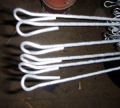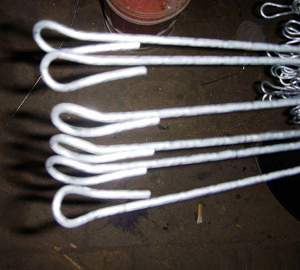1 / 2
Baling wire
Product description
Baling wire, otherwise known as "farm wire" or "soft wire," is used in an agricultural setting and industrial setting for everything from mending fences to manually binding a rectangular bale of hay, straw, or cut grass. It is also used to band together condensed cardboard, textiles, aluminum and other materials that are processed in the recycling industry.
Spelling note: "Baling wire" is sometimes misspelled as "bailing" wire, but "bailing" usually refers to a leak or flood, as in "bailing" out a leaky rowboat with a pail, or bailing out a bank with funds to keep it afloat.
Baling wire is commonly used in many non-agricultural applications, usually in an informal, make-do manner. It is frequently referred to as one of the basic repair materials. Typical uses range from supporting loose mufflers to patching chain-link fences. Common phrases often include baling wire as an ad hoc, fix-anything material, alongside chewing gum, duct tape, and the cable tie.
It is also known as "haywire," from which the term "go haywire" arose, referring to crazy or mixed up from the wire's use to fix anything in an ad hoc manner.[1]
Its closest industrial (proper name) is Mechanic's Wire (Soft Annealed Mechanic's Wire, 18 AWG)
In the United States, Australia, and around the world, baling wire was used in mechanical hay balers pulled behind a tractor. The balers used a wire twister that first cut then twisted the ends of the wire such that the bale kept its shape after the baler had pressed the hay into a tight rectangular bale. These hay balers were in common use up until the late 1980s. When the hay was fed to the stock the wire was cut and hung in bundles around the farm. Farmers used the soft wire for fixing almost everything you could think of on the farm. From old leather horse harness to pins to keep castellated nuts in place on the tractor. Even tiny screwdrivers were made by cutting a short length of wire and looping one end for grip. The other end was then flattened and shaped to make a screwdriver for specialized tasks like replacing the tiny screws in reading glasses.
Baling wire was a commonly-used product for many years but it has since been replaced by baling twine in the late 1970s.
Send your inquiry to this supplier















